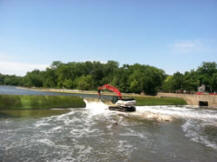|
Optional Field Trip Information (Monday, July 29)
COMBINED Fish Passage / Chicago Metro Field Trip (8:00am-5:30pm) -- $75.00
Itinerary:
(Printable
PDF)
| 8:00am |
Board the bus and leave Hotel - Give overview of the Des Plaines River Dams and the Corps' role as the lead coordinating agency for the removal of all 12 or so dams and weirs |
| 9:00am |
Arrive at Hofmann Dam - discuss how dam was removed and the impacts of dams on hydrology, hydraulics, geomorphology, sediment transport, habitat connectivity, and ultimately aquatic organisms. |
| 9:45am |
Load bus to Electric Dispersal Barriers |
| 10:15am |
Arrive at Electric Dispersal Barriers Site |
| 10:30am |
Tour and Discussion of Electric Dispersal Barriers Program and Facilities - Discuss the importance of the Chicago Sanitary & Ship Canal for the interbasin movement of aquatic invasive species between the Great Lakes & Mississippi River basins & the objectives & history of the barriers project. Tour the 3 operational barriers & explain how they work & how USACE evaluates their effectiveness. Discuss the next barrier (for which construction will be starting this summer) & discuss future plans for barrier operations & monitoring. |
| 11:15am |
Load Bus to South Shore Nature Sanctuary |
| 11:45am |
Arrive at South Shore Nature Sanctuary tour and discussion - A three and a half acre prairie, small wetland and emerging sand dune that serve migratory birds and butterflies. This site celebrates a legacy of community advocacy and landscape architect Jens Jensen's vision of "Prairie style" community meeting spaces. |
| 12:15pm |
Lunch Break |
| 1:15pm |
Leave for 63rd Street Beach |
| 1:30pm |
63rd Street Beach Tour and Discussion |
| 2:15pm |
Leave for Burnham Wildlife Corridor |
| 2:30pm |
Arrive at Burnham Wildlife Corridor - Discuss the importance of lakefront bird and wildlife habitat, and the process of transforming human-oriented turfgrass into a human and wildlife friendly natural area. |
| 3:00pm |
Leave for Northerly Island |
| 3:15pm |
Arrive at Northerly Island - Tour the early construction stages of recreating coastal habitats on 40 acres of a manmade island which includes connecting a pond and wetlands to Lake Michigan for native fish spawning and mudpuppy habitat. We'll also discuss the site's importance for recreation and migratory bird routes as well as plans to construct additional islands, dunes, and reefs lakeward of the existing project. |
| 4:00pm |
Board Bus and return to Hotel |
| 5:30pm |
Arrive at Renaissance Hotel |
 Hofmann Dam Removal Hofmann Dam Removal
Des Plaines River between Riverside and Lyons, IL;
Millbridge Rd and Fairbank Rd, Lyons, IL
Restore 57 miles of free flowing river by removing 2 dams and notching a 3rd dam; stabilize and revegetate 1200' of shoreline; construct a channel from Swan Pond Park
Web Site:
fpdcc.com/hofmann-dam-removal-project/
Video:
www.youtube.com/watch?v=EjkSDYoQk1c
Electric Dispersal Barrier (Asian Carp)
Romeoville, IL Chicago Sanitary & Ship Canal
Dispersal Barrier for Invasive Species to the Great Lakes: The dispersal barriers are located in the Chicago Sanitary and Ship Canal, which is a man-made waterway creating the only continuous connection between Lake Michigan and the Mississippi River basin. The dispersal barrier system was developed to deter the spread of invasive fish species between these watersheds. It consists of three electric barriers which have steel electrodes mounted across the bed of the canal. On-land equipment sends a pulsing DC current through the electrodes, creating an electric field in the water that discourages fish from swimming through.
Web Site:
www.lrc.usace.army.mil/Missions/CivilWorksProjects/ANSPortal/Barrier.aspx
Photos:
www.flickr.com/photos/usacechicago/sets/72157627138482598/with/5911792313/

63rd Street Dune and Beach
Downtown Chicago
6300 S. Lake Shore Drive, Chicago, IL.
Restore 14 acres of dune and beach and 7 acres aquatic habitat along Lake MI shoreline. . The 63rd Street Dune restoration project is approximately 21-acres in size and includes lacustrine, beach and dune habitat. The lacustrine portion includes natural cobble pockets along the existing jetty as habitat for invertebrates, fishes and potentially mudpuppies. Placed on top of the cobble pockets are sunken trees to increase the vertical habitat structure for fishes. Two coastal plant communities were restored, one along the current beach area and one landward of the beach, with native dune grasses including marram grass and little bluestem grass. Prickly pear cactus can also be found in the restored dune area. The state endangered sea rocket has established colonies in the area between the water and the dune. This natural area is used during the migration seasons by waterfowl, and several species of shorebirds were observed: including the Tricolored Heron and the Federally endangered Piping Plover.
Web Site:
www.lrc.usace.army.mil/Missions/CivilWorksProjects/63rdStreetDune.aspx

Burnham Wildlife Corridor
Downtown Chicago
McCormick Pl and Lake Shore Drive, Chicago, IL
The Burnham Wildlife Corridor is 100 acres of planned and existing natural areas in Burnham Park. The corridor includes prairie, savanna and woodland sections. When complete, it will be the largest contiguous natural area along the Chicago Lakefront. The length of the corridor stretches over two miles, from McCormick Pl to E 47th St. The Chicago lakefront is a tremendous recreational asset to the city, but it also has crucial value to migratory bird routes.
Web Site:
www.doi.gov/news/pressreleases/Salazar-Announces-1-million-for-Millennium-Reserve-Restoration-and-Conservation-Projects.cfm
Video:
www.youtube.com/watch?v=71YVxFOU6s8&feature=player_embedded

Northerly Island
Downtown Chicago
1300 S. Lynn White Drive, Chicago, IL.
Re-create 40 acre wetland, pond, prairie, savanna, and lacustrine habitats; connect pond to Lake Michigan for fish spawning habitat
Web Site:
en.wikipedia.org/wiki/Northerly_Island
General Information:
Recommended Clothing: Dress for walking---lightweight long sleeved shirt, hat and sunscreen. Flip Flops are appropriate for the beach stop only.
Required Clothing: long pants and closed toe shoes that cover the whole foot are required at the Electric Dispersal Barrier stop. Shorts and skirts are not allowed.
Food provided: Lunch, water and snacks.
For Questions about the Tour Sites:
Contact:
Robbie Sliwinski, Army Corp of Engineers |
Email: Robbie.sliwinski@usace.army.mil
For Questions about Tour Logistics:
Contact:
Sharon Borneman or Jasmine Garcia, UF/IFAS Office of Conferences & Institutes
Email:
spb@ufl.edu /
j.garcia@ufl.edu
|